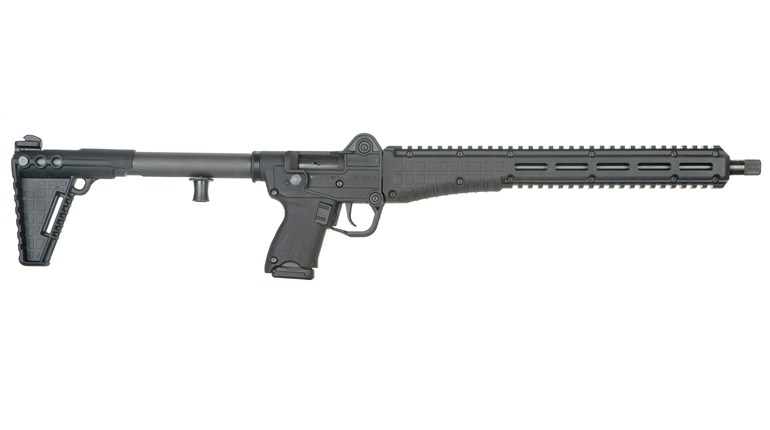
The Heckler & Koch VP9 Match, a longslide version of the German gunmaker’s flagship VP9 striker-fired, semi-automatic pistol, is one of the newest members of HK’s VP9 and SFP9 family. The VP9 Match quietly made its debut in 2021. Even in 2024, it’s still an under-the-radar handgun. With my interest in longslide performance pistols, the VP9 Match has been on my mind for some time, especially considering that the standard VP9 is a well-regarded, accurate and reliable striker-fired pistol.
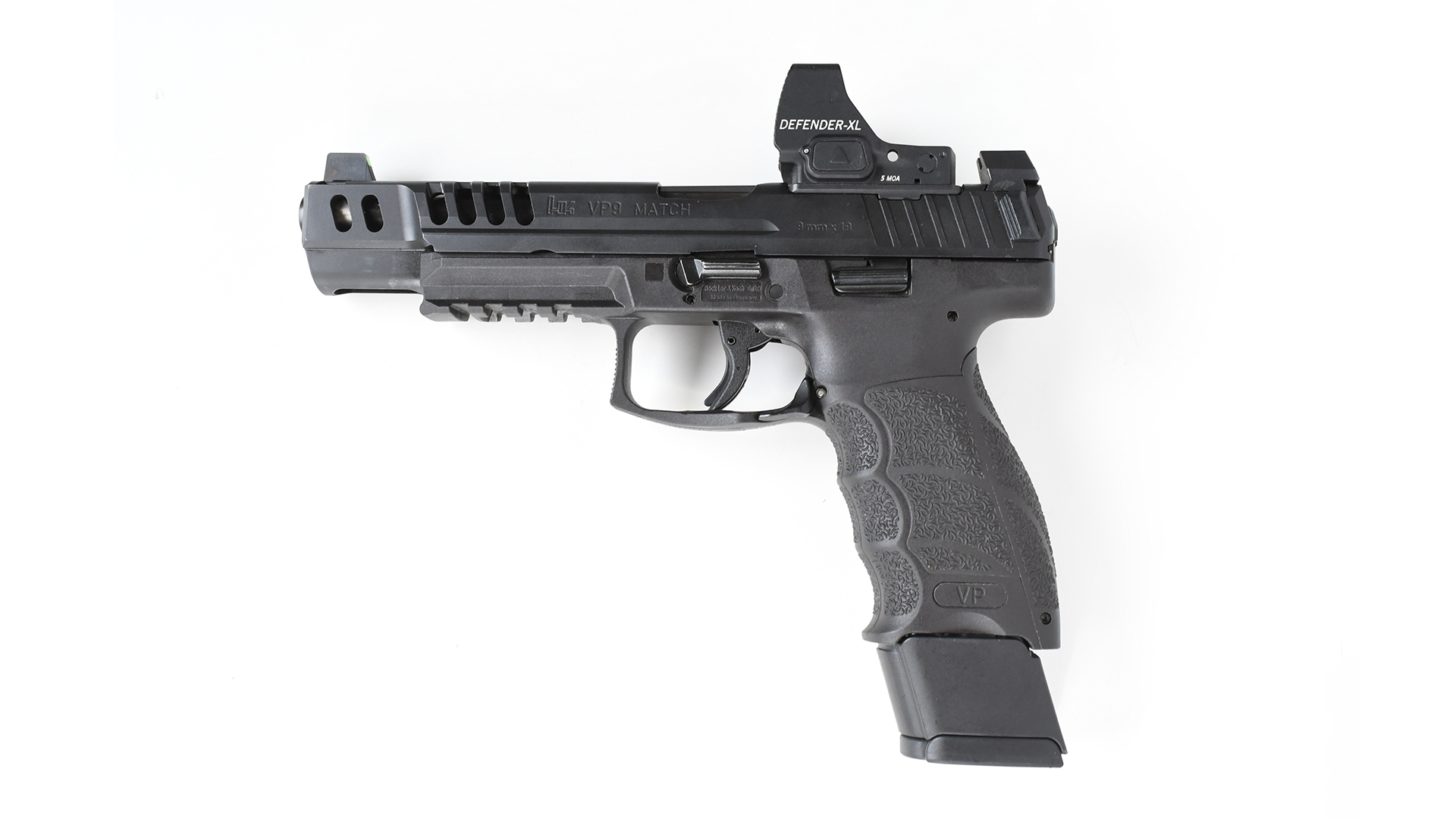
VP9 MATCH OVERVIEW
The VP9 Match chambered in 9 mm Luger is a striker-fired, polymer-framed semi-automatic pistol that works off the proven Browning delayed blowback system, naturally with HK’s own tweaks. Unlike standard VP9s, the VP9 Match includes two different RSAs (recoil spring assemblies). These RSAs are either painted blue (lighter spring) or red (standard spring) and provide shooters a chance to lightly tune the pistol to their liking. Instead of the standard VP9 17-round magazine, the VP9 Match ships with four 20-round extended baseplate magazines.
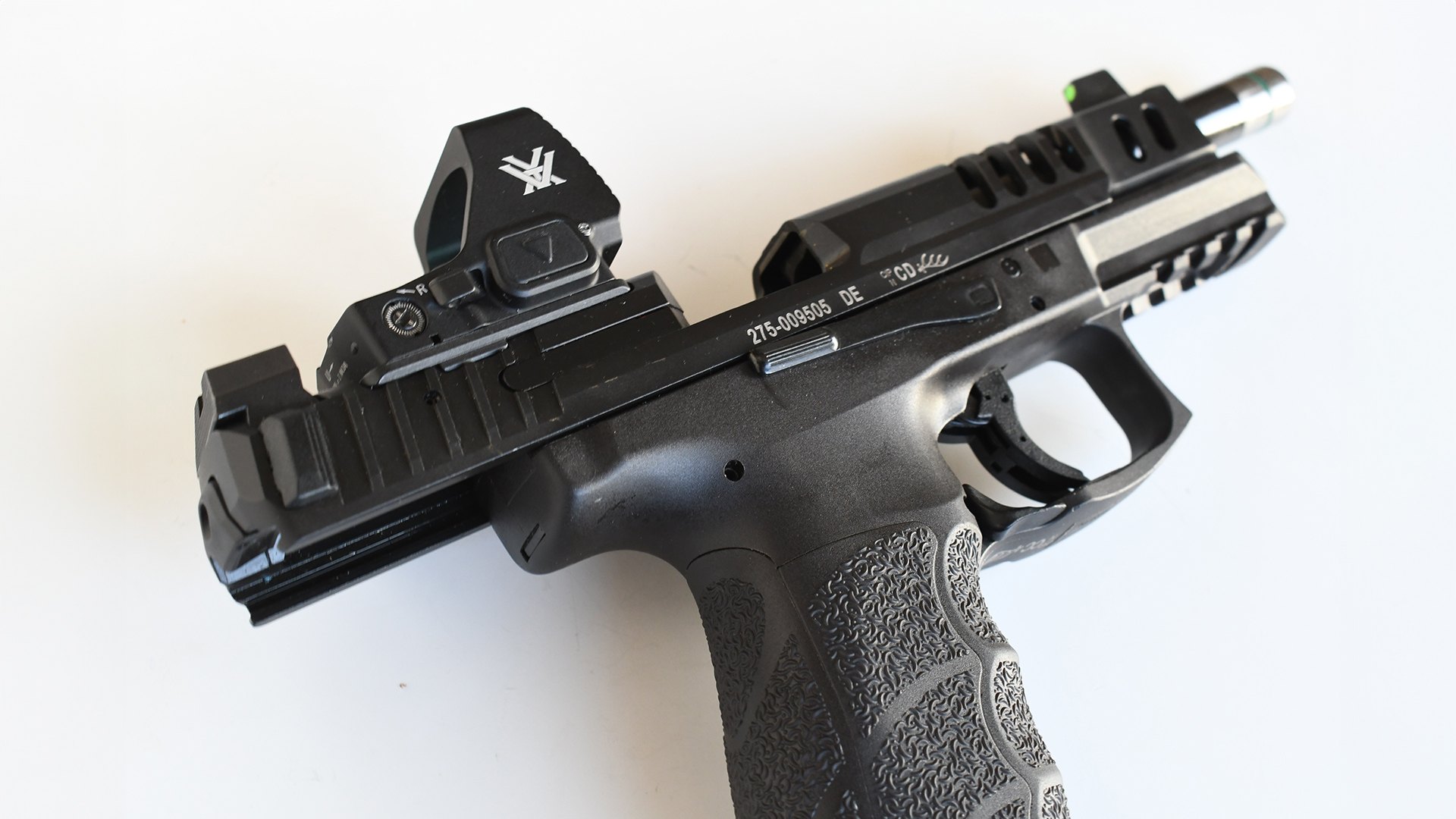
HK VP9 GRIP & FRAME
The lower half of the pistol is virtually identical to that of the standard Heckler & Koch VP9; these frames are fully ambidextrous and have ergonomic pistol grips, too. The VP9’s frame “claim to fame” is its unique and interchangeable backstrap and grip panel system—something VP9s share with HK P30s. Mixing and matching parts, you can customize these with 27 different permutations, making the VP9’s grip system more sophisticated than typical pistols in this class that usually only have interchangeable backstraps.
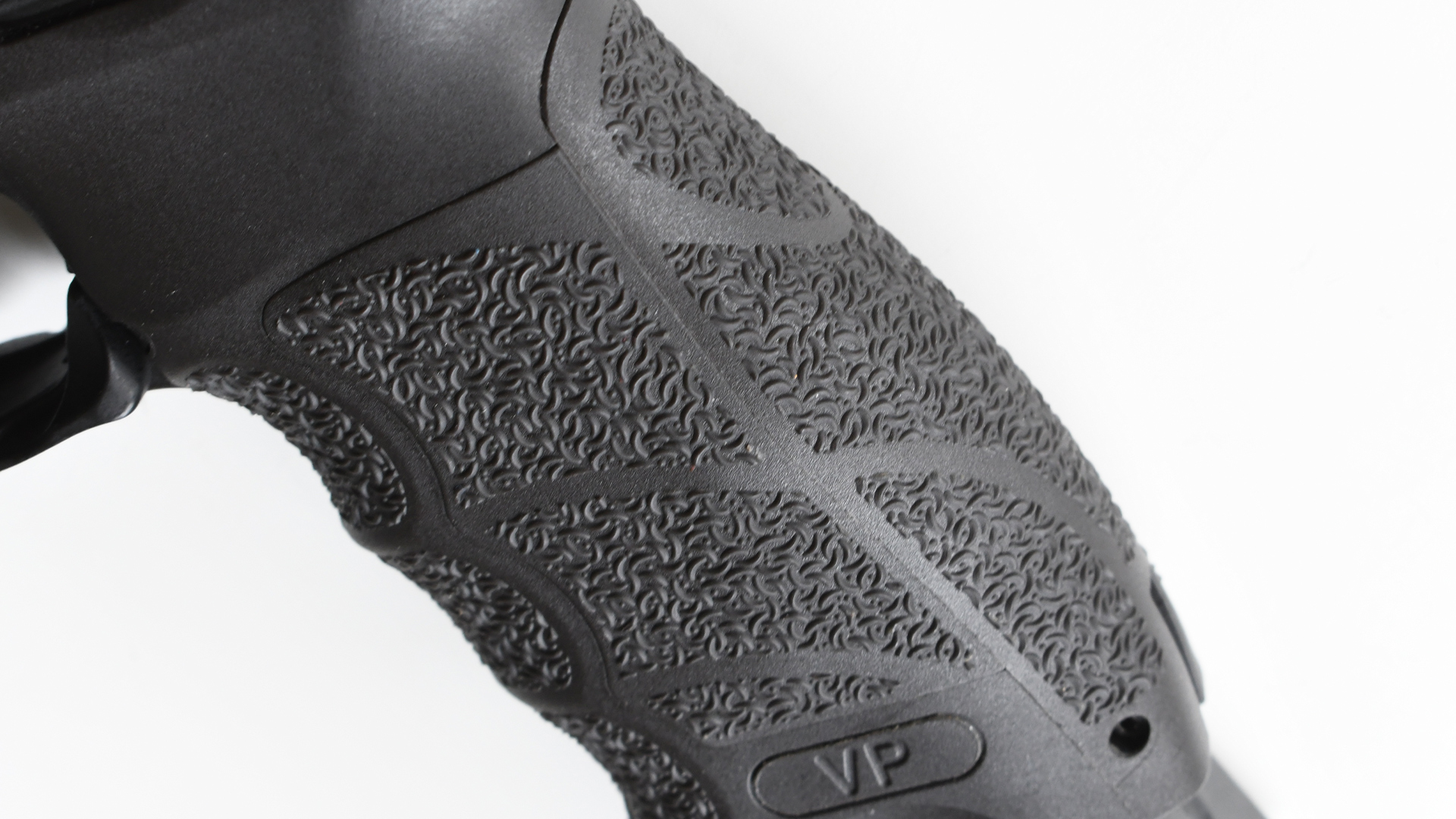
The VP9 frames also have the famous (or infamous) HK-style paddle magazine releases. To their credit, the levers on the paddle are neither too big nor too small and they seamlessly integrate into the trigger guard without clashing with the trigger finger or firing grip. Whether left- or right-handed, I found it best to actuate them with the index finger of the firing hand. It’s also worth mentioning that Heckler & Koch also offers “B-model” VP9s with traditional button magazine releases.
THE TRIGGER
The trigger on the VP9 Match includes a bladed safety and the trigger face itself has a gentle curve that is not too narrow or too wide. In addition, the trigger’s bladed safety doesn’t feel obtrusive; during shooting, it’s easy to forget it’s even there. More importantly, the VP9 Match trigger’s travel is smooth for its entire duration, from take up to the break. It feels like a two-stage trigger that has approximately 1/3-inch of takeup until it reaches the breaking point (wall). Surprisingly, even though the HK VP9 Match’s trigger averaged to four pounds, nine ounces, it’s so smooth that it doesn’t feel like a regular 4½-pound trigger. Nonetheless, the break feels crisp and consistent without any overtravel. Trigger reset involves the trigger moving forward approximately more than 1/4-inch, but not quite 1/3-inch. Thanks to its pre-tensioned striker, the trigger is quite consistent and easy to manage.
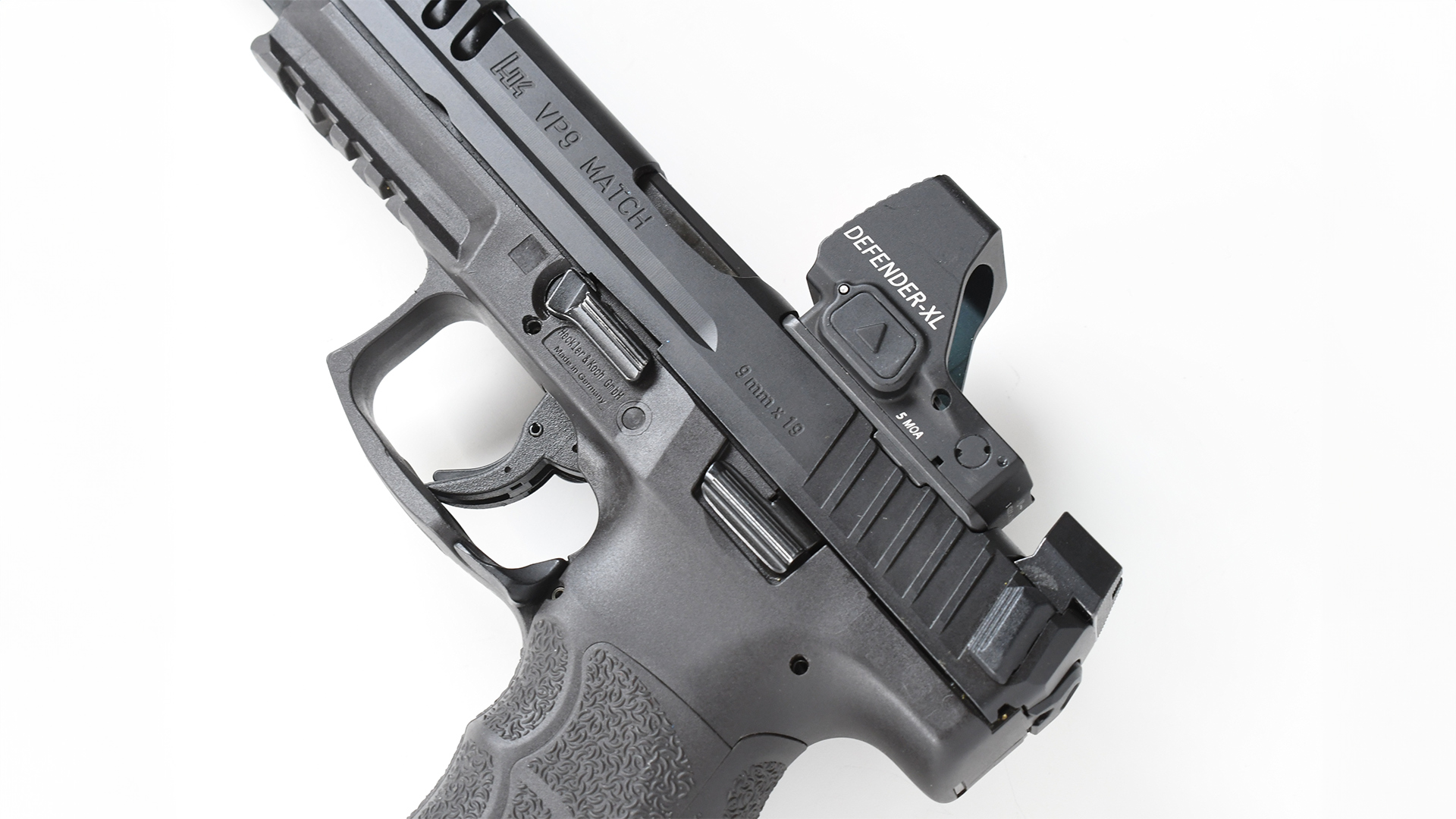
SLIDE & BARREL
As mentioned, the VP9 Match’s most notable feature is its longer slide and 5½-inch barrel. Its optics-ready, extended length slide has prominent lightening cuts on either side behind the muzzle, along with a portion on top just behind the front sight. The lightening cuts also work well as forward slide serrations. Including the cuts on a longer slide is both a matter of practicality and performance. But these serrations can be visually striking, too. Additionally, all VP9 slides have a pair of polymer “ears” at the rear of the slide that serve as low-profile, slide-racking aids.
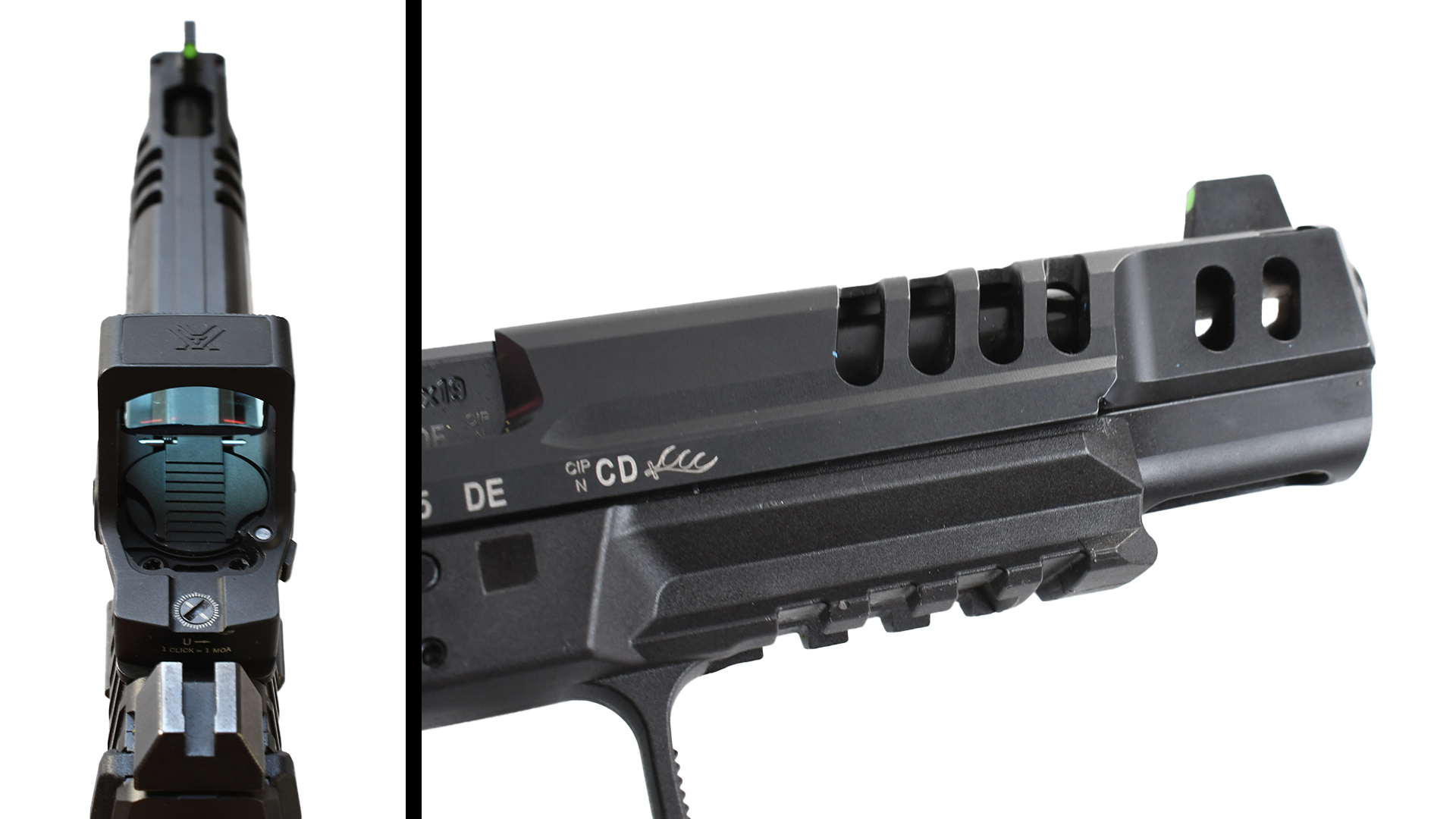
Heckler & Koch handguns are known for their durability and reliability, and a core element of this stems from their barrels, made from what the company describes as “cannon-grade steel.” Heckler & Koch barrels are also cold-hammer forged with polygonal rifling. All VP9 barrels have stepped-chamber design, and the VP9 Match’s barrel is no exception. Stepped chambers have a subtle constriction near the chamber mouth with the goal of both keeping expanding gasses sealed and aligning the cartridge as concentrically as possible while it sits in the breech. Spent brass is ejected with a circular impression near the case mouth due to this constriction. Something unique to longslide VP9 pistols are polished barrel sections. Situated behind the muzzle, these smoothened areas also have a groove for an O-ring that serves as a bushing between the outer circumference of the barrel and the inner edges of the slide’s muzzle cut-out from which the barrel protrudes. The polishing and O-ring are intended to promote more assertive lockup to aid accuracy.

AT THE RANGE
I fired approximately 400 rounds through the VP9 Match with my usual approach of combining both factory and handloaded ammunition. I grouped and measured data from Federal Ammunition’s 115-grain Syntech and 147-grain Gold Medal Action Pistol rounds. I also grouped Staccato’s 124-grain FMJ Range cartridge as it has proven to be consistent across the board, and I wanted to see what the VP9 Match could do with it. (I wasn’t disappointed). My handload, a 1,200 f.p.s., 127-grain cast powder-coated bullet with a charge of 4.2 grains of Titegroup, made up the other 75% of my shooting. For the three factory loads, mean group size between their averages was 1.635 inches at 25 yards. I also printed 10-round groups at 25 yards with the same three loads and managed to get a sub-two-inch group with the 124-grain Staccato load. Federal’s 115-grain Syntech and 147-grain Gold Medal Action Pistol loads weren’t far behind at around 2¾ inches. Even so, these readings between the two furthest shots in the group don’t do the gun or ammunition justice—the VP9 Match lacks for nothing in terms of accuracy.

Regarding reliability, I have nothing negative to report. This pistol fired, cycled and ejected every round put through it without issue; the ejection pattern does not interfere with the slide-mounted dot, either. The combination of a comfortable and customizable ergonomic pistol grip along with a great trigger make the VP9 Match an easy shooter. In my case, the new Vortex Defender-XL five-MOA “big window” red-dot optic mounted on this pistol also enhanced my shooting experience. Its square window provides a stellar field of view.
Besides shooting groups, I brought the VP9 Match to a local club USPSA match. Several stages had targets and poppers that were best engaged with long 20-plus-yard shots. It was easy to get quality A-zone impacts or knock those poppers down quickly. Overall, I’m satisfied with the gun’s performance in the match. Though the magazine well seems tight and narrow, I had no problems reloading under pressure during the USPSA match. Because I shoot left-handed and use my trigger finger to push left-sided magazine catches, the HK-style paddle release presented no issue to me; it is the same motion.
SHOOTING RESULTS

FINAL THOUGHTS
Most of my criticisms of the VP9 Match actually have nothing to do with the gun itself. But I can touch on these briefly. As a competition-focused gun, a set of fiber-optic sights from the factory would be more convenient. Though ergonomic and comfortable, the standard grip texture is lacking for a competition focused pistol, something that became apparent while shooting my match in the Texas summer heat and humidity.
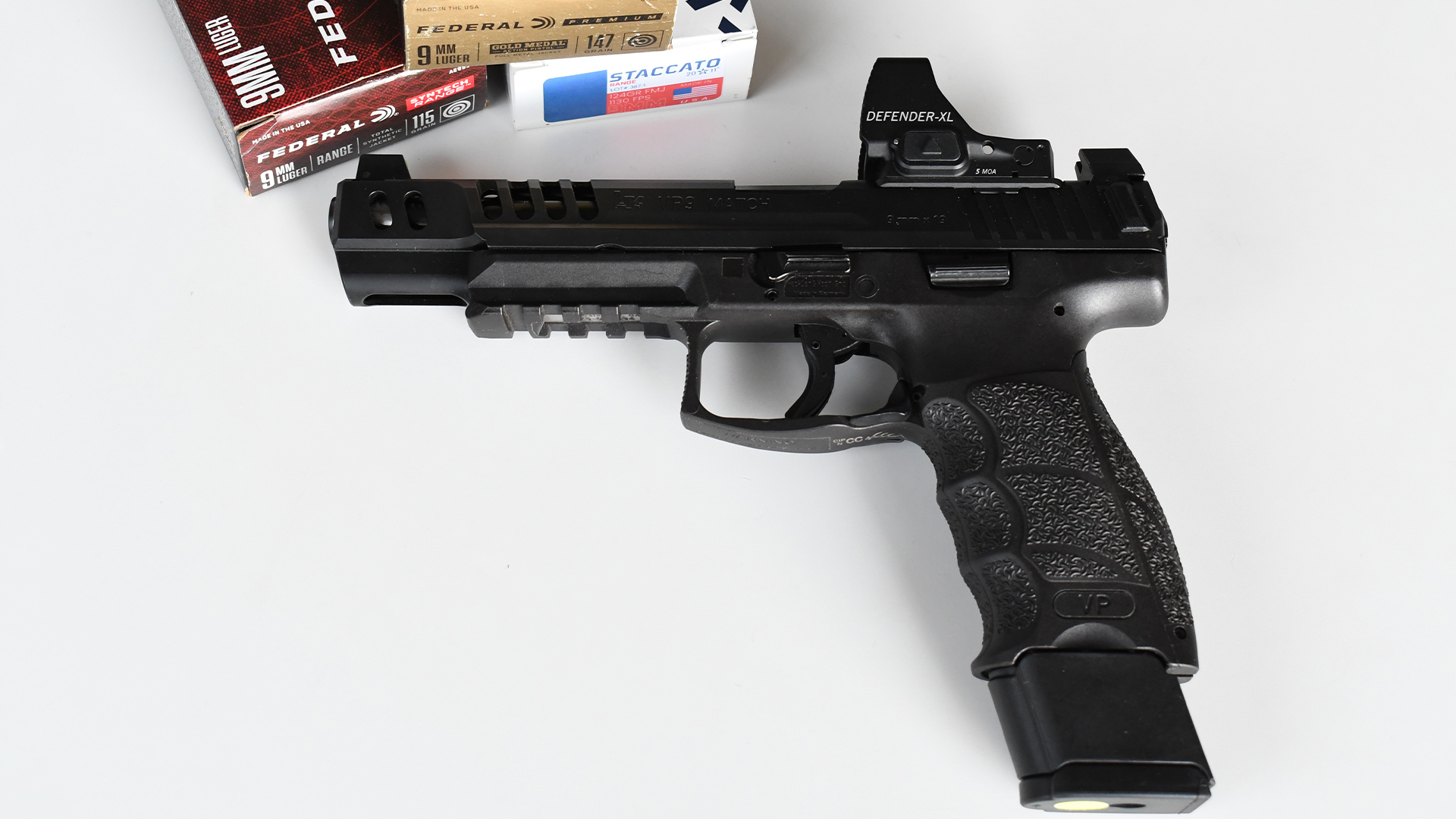
My chief complaint is with the factory magazines. Even though HK-produced magazines have a reputation for extreme reliability and it’s also wonderful the company provides four magazines with each pistol, these aren’t much help due to the tall basepads. These magazines aren’t compliant for the divisions in popular action-pistol sports like USPSA or IDPA, where the gun would be the most relevant. These magazines make the gun too tall for either the IDPA or USPSA Production boxes. For USPSA Limited, Limited Optics and Carry Optics, the magazines are just slightly longer than maximum allowed length of 141.5 mm. At the match, I had to compete under the USPSA Open (minor) division to not run afoul of magazine length limits. While it wasn’t a big deal at a casual weekend club match, it’s also not the most competitive gun for Open division. Despite being a larger pistol, the VP9 Match is just under the maximum length limits for both the IDPA and USPSA boxes. In fact, as of this writing, the VP9 is finally on the USPSA Production gun list. For the sake of competition, it would be better if they were sold with four 17-round magazines, allowing competitors to adjust for their respective division.
I previously reviewed the original Heckler & Koch VP9 for Shooting Illustrated, an official journal of the NRA and Shooting Sports USA’s sister publication. In that review, I refer to the original VP9 as an overengineered, German-manufactured striker-fired pistol. Naturally, the VP9 Match follows suit—a premium, striker-fired pistol built around sophisticated and high-quality assemblies. With regards to its mechanical prowess and accuracy, there’s nothing the VP9 Match technically lacks—aside from certain details that clash with rulesets, these pistols put bullets directly where they’re aimed.
SPECIFICATIONS
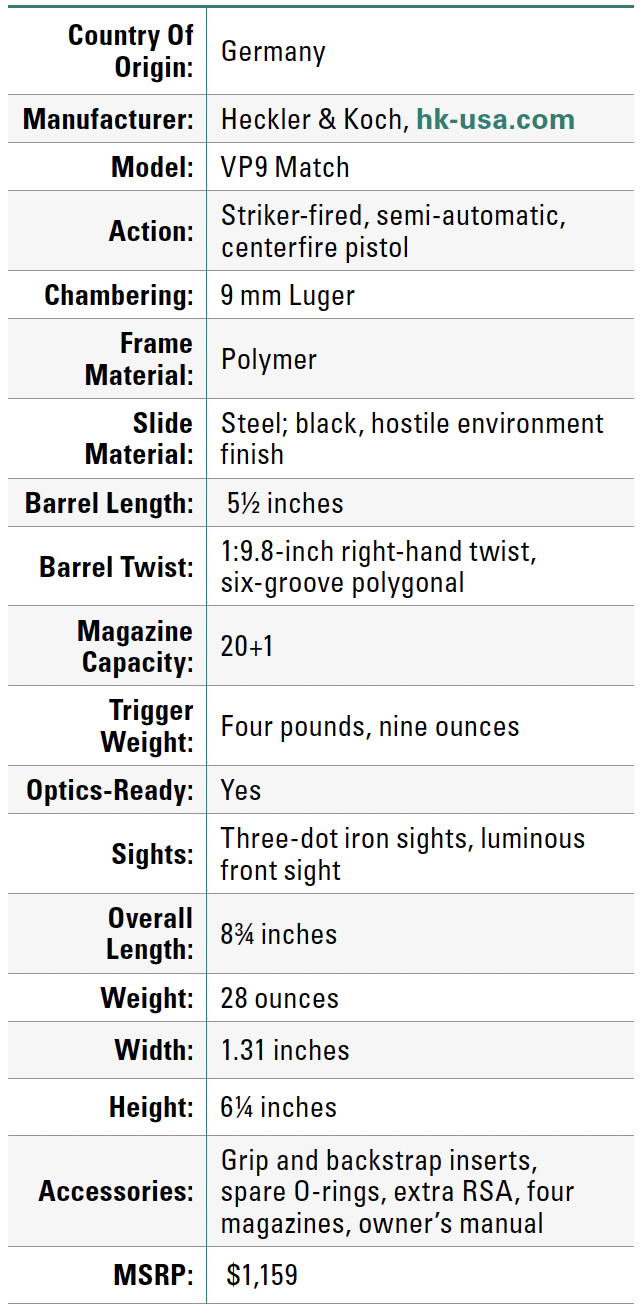
Learn more at hk-usa.com.
















